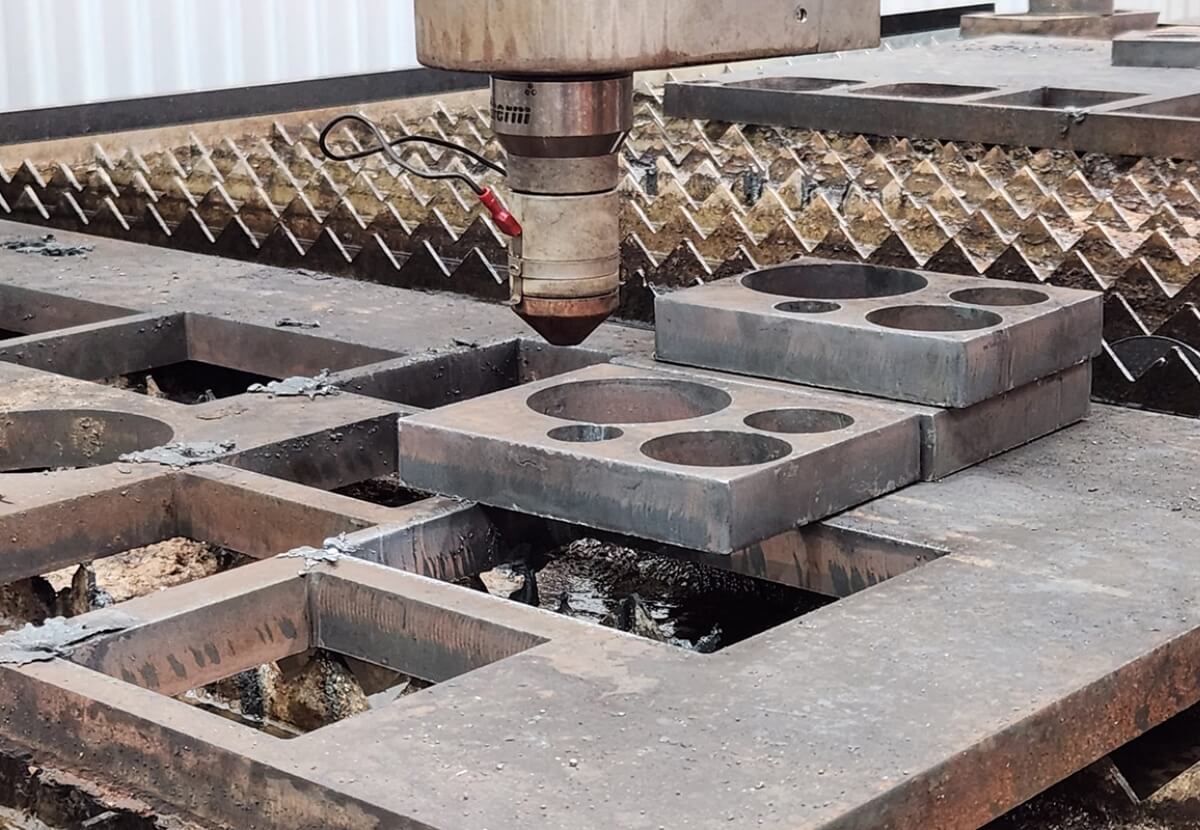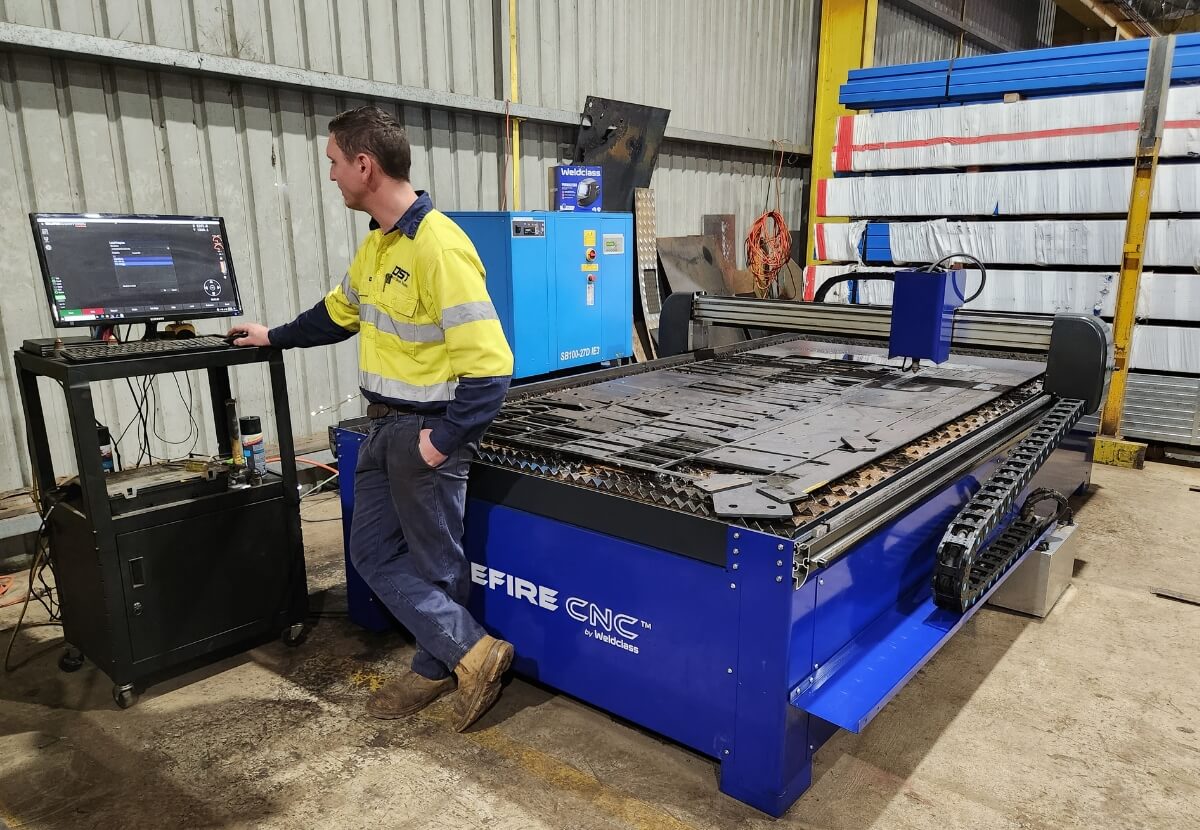Laser cutting may be a popular choice in fabrication, but it’s not always the best fit for every job. Depending on your material, budget, and cutting needs, laser cutting alternatives like waterjet cutting, oxy cutting, and plasma cutting can offer greater efficiency, cost savings, or versatility.
In this article, we break down the top alternatives to laser cutting, comparing their strengths and ideal applications so you can find the best solution for your fabrication needs — without the hefty price tag of a laser cutting machine.
Types of industrial cutting machines
Cutting machines come in various types, each with different technologies.
- Laser cutting machine
- Waterjet cutting machine
- Oxy cutting machine
- Plasma cutting machine
Laser cutting
Laser cutting machines use a highly focused laser beam to melt, burn, or vaporise the workpiece material. This is a great option if you are cutting thin sheets between 0.5mm and 15mm but the efficiency drops significantly as the thickness increases. In these cases, you may be better to opt for plasma cutting.
While laser-cutting machines are known for their precision, this does come at a higher cost than alternative technologies.
Waterjet cutting
Waterjet machines use a high-pressure stream of water to cut, sometimes mixed with an abrasive substance. This is popular for cutting a range of materials, including metal, stone, glass, ceramics, composites, and even food products. The key benefit of waterjet cutting is that it doesn’t produce any heat, meaning there are no heat-affected zones or material distortion.
Oxy cutting
Oxy cutting uses a combination of oxygen with a fuel gas like acetylene, propane, or natural gas. This is used to produce a high-temperature flame that cuts through metal by melting it. Oxy-cutting is mostly used for cutting carbon steel.
Plasma cutting
Plasma cutting uses electrically ionised gas, or plasma, to cut electrically conductive metals. The plasma is superheated and directed through a torch to precisely cut the workpiece. Plasma cutting is particularly effective for cutting steel, stainless steel, aluminium, brass, and copper.
Plasma cutters can handle a wide range of materials and thicknesses with cutting speeds of up to 500 inches per hour. With the use of automated CNC software, plasma cutting also reduces material waste and enhances workplace safety. Compared to laser cutting, CNC plasma excels in cutting thicker materials and generally incurs lower operating costs.
For more in-depth comparisons, read our blog comparing Plasma vs Waterjet vs Laser vs Oxy.

Which method of cutting is right for you?
Choosing the right cutting method depends on your budget, material, and precision needs. While laser cutting is fast and precise, it comes at a higher cost. For many fabrication applications, a plasma cutter delivers a more cost-effective solution without compromising performance.
One of the main reasons to invest in a laser machine is when you need an exceptionally high cut quality with no dross or edge bevel. For example, laser cutting would be invaluable if you manufacture surgical instruments that require micron-level accuracy.
On the other hand, oxy-cutting machines have a lower purchase price, which may be tempting. But the high running costs, slower speeds, and inconsistent cut quality may impact your decision. Similarly, the waterjet offers exceptional cut quality but at a higher cost and slow speeds.
Why plasma cutting stands out
For most manufacturers and fabricators, a CNC plasma cutting machine provides precision, efficiency, and affordability, making it the ideal alternative to other cutting methods for a wide range of applications. It provides:
- Low initial investment.
- Cuts a wide range of materials.
- Good cut quality.
- Fast cut speeds.
- Low operational and maintenance costs.

What is CNC cutting?
CNC stands for Computerised Numerical Control, a technology that revolutionises precision cutting by integrating automated control into plasma cutting systems. Instead of relying on manual operation, CNC plasma cutters use advanced software to guide the cutting torch with pinpoint accuracy, ensuring each cut is consistent and precise.
By eliminating the risk of human error, CNC plasma machines significantly improve efficiency, reduce material waste, and enhance safety in the workplace. The software automates the cutting process, allowing for complex designs, intricate cuts, and repeatable results – all at high speeds.
Here at SUREFIRE, our plasma machines are controlled by SURECONTROL™ CNC cutting software. We also incorporated a built-in CAM module to complete each step for you automatically.
Our CNC Plasma Cutters
For more information on CNC plasma machines, download our free Buyer’s Guide. We’ve included everything about our industrial plasma cutting range, including our Surefire plasma tables specifications and pricing, information on the Surecontrol software, and our CNC plasma cutters.
- Compare models and specifications.
- Product pricing.
- Key features and optional extras.
- Find the right machine for your business.
Download your free copy below!
Related Posts
When it comes to high-precision cutting technology, two of the most widely used options are plasma cutters and laser cutters. …
One key goal for most businesses, regardless of industry, is to boost revenue and improve profit margins. The question is…
Work with us today
For more information on our products, services, and solutions, and to get pricing, please click on the button below.

